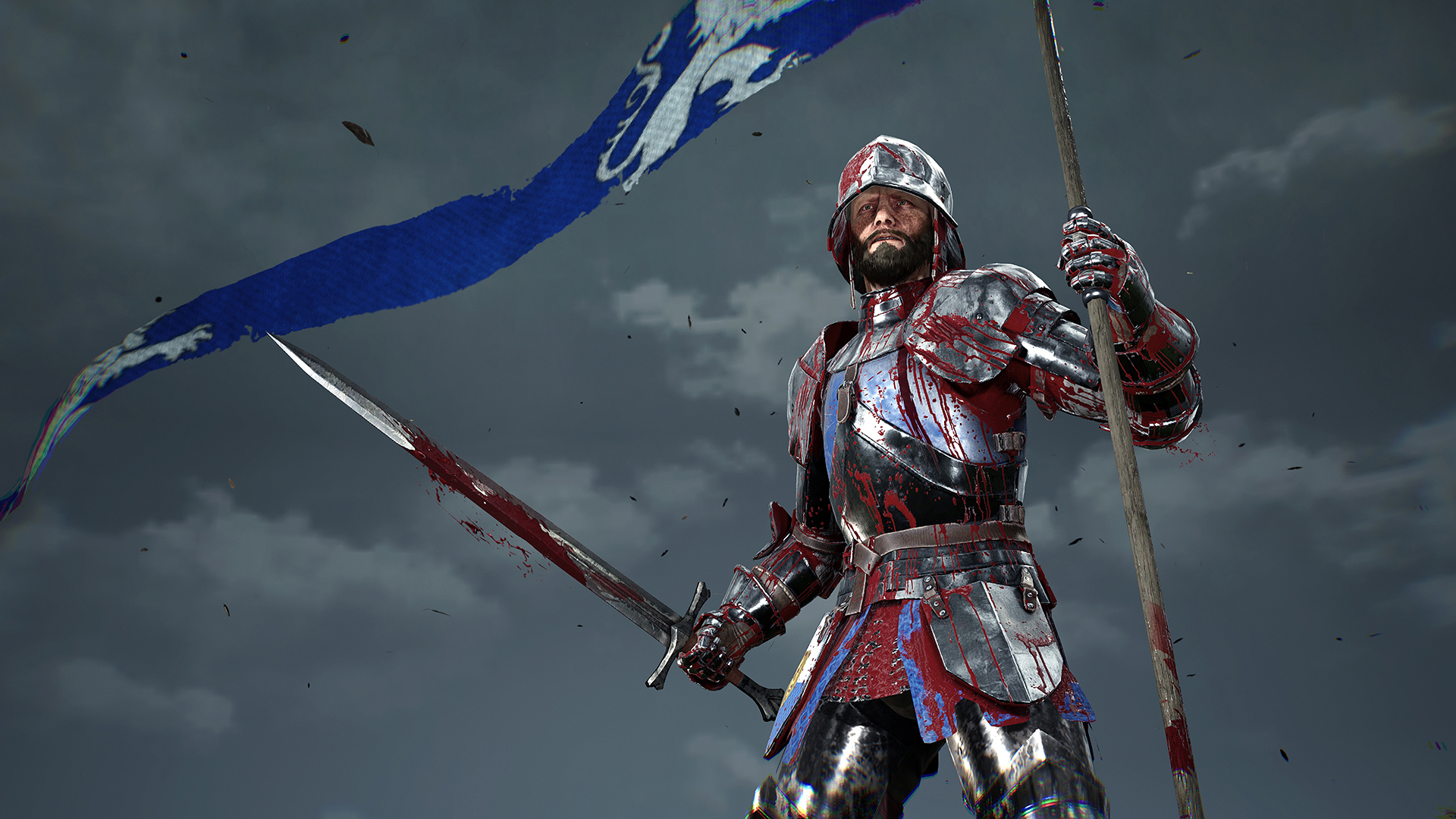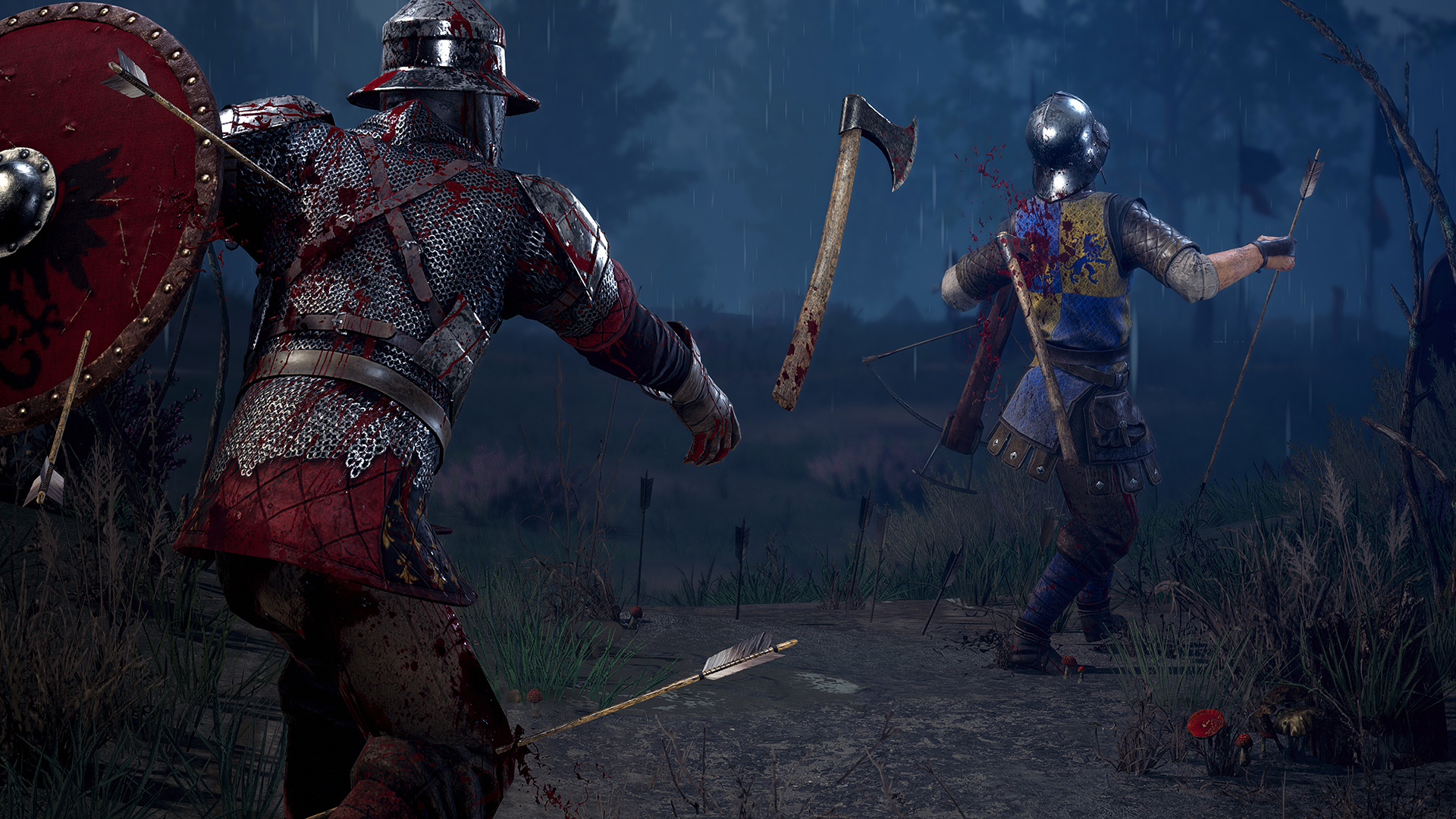Chivalry 2's medieval combat is nuanced, gory, and spectacularly fun
Heads and limbs fly in a new gameplay video, plus our hands-on impressions of an alpha version.
VIDEO: See Chivalry 2's combat in motion above, taken from an alpha version. Also available on YouTube.
There are many, many ways to swing a sword in Chivalry 2. You can get by with just the basic left mouse button swipe, but with the configuration I used, both of the mouse's side buttons were also bound to swings, spinning the mouse wheel up threw a sneaky jab, spinning it down swung from above, and a special attack was bound to Q. There's also a kick key, a key to throw your weapon, "directional crouching," and a yell key, for when you just need to yell.
My time with an alpha version of Chivalry 2 was brief, and I didn't want it to end. It was fun even as an indiscriminately flailing newcomer to the genre, but what got me excited was the sense that a person could get fantastically good at swinging one of its swords around—that it's a game grounded in physical techniques.
Even so, Torn Banner Studios says it isn't trying to make a sword fighting sim. Like its 2012 predecessor, Chivalry 2 is designed as a multiplayer medieval battle sim: It's about moshing with steel, swinging and stabbing and blocking (and yelling) as arrows and limbs and heads streak by. There's a map in which attackers push battering rams up to castle gates before breaking through, choked clashes on bridges, longbows and crossbows, horses, and a brief stage in one map where defenders begin as peasants struggling to poke invading soldiers to death with pitchforks.

Mordhau, which was built by fans of the original Chivalry, similarly goes after the full scope of medieval warfare. Aside from the visual differences (Chivalry 2 looks much better), it'll be the details that differentiate them: the specifics of Chivalry 2's map layouts and objective designs, class loadouts, animations, and combat flow.
There are going to be the "drunk on a Saturday night" players who'll fill the grunt roles, and then there'll be the Achilleses who'll come charging out of a pile of bodies without a scratch.
I didn't get to play Chivalry 2's 64-player objective-based maps during my preview session, just smaller team deathmatch rounds. In group fracases, blades came from all angles—from enemies as well as teammates, who sometimes clumsily killed me. I sometimes clumsily killed them, too. We're all swinging longswords, axes, and greatswords around at the same time, so there's bound to be accidents. But finesse definitely isn't impossible.
When I remembered to, I blocked, dodged, and ducked—hitting Control plus a directional key gives an angled sway to crouches, like a boxer bobbing and weaving. When I attacked I tried to do what Torn Banner taught me to, dragging the mouse in the direction of my swing to speed up the movement. Their metaphor for Chivalry 2's controls is useful: WASD controls your feet, the mouse controls your hips, and the attack buttons control your arms (I added that last part, but it works). So I first need to plant my feet within range of an enemy, then left click to launch my arms into a swing from my right shoulder, and then flick the mouse to the left as if I'm twisting my torso to throw more power behind my arc.
Keep up to date with the most important stories and the best deals, as picked by the PC Gamer team.

I tried to do all of that, but it's one thing to understand that it is possible to gracefully duck under swings, parry them, block them, throw feints, and chop down one, two, three attackers in a row like Henry Cavill's Geralt when he's having a bad day, and it's another thing to do it. Despite what Torn Banner says, my impression is that Chivalry 2 is a quite complex sword fighting sim. It's not just a sword fighting sim, but I would've happily ditched team deathmatch (and the annoying archers who stand in the back) for a one-on-one skirmish with more space to practice little feints and surprise pokes.
As Torn Banner puts it, there are going to be the "drunk on a Saturday night" players who'll fill the grunt roles, and then there'll be the Achilleses who'll come charging out of a pile of bodies without a scratch.
Medieval menagerie
Sword combat in Mordhau is broadly similar to sword combat in Chivalry 2, in that Mordhau also binds a thrust to Mouse Wheel Up and an overhead blow to Mouse Wheel Down, and includes feints and ripostes and all the same medieval accouterments, such as axes and shields. But they're in no danger of being identical.
Chivalry 2 didn't feel as twitchy in my experience. To parry in Mordhau, you tap the right mouse button just before your opponent's swing connects. In Chivalry 2, you can hold down the right mouse button to sustain a guard, but your opponent will have the advantage on their next attack after a block unless you can slip in a jab, throw a counter, duck, or reorient. Both are fast, but Chivalry 2 feels smoother: a block isn't a flash of lightning, but part of a complete movement that blends into your next strike.
With the caveats that Chivalry 2's animations aren't final and it's hard to gauge these things in a short session, my body and sword felt heavier in Chivalry 2 than they do in Mordhau—I had the sense that I was heaving back and forth with more force.

Torn Banner founder Steve Piggott says he wants Chivalry 2 to feel like a bar fight more than a fencing match. There's a new heavy strike which won't deal damage through a block but will continue past it, potentially catching another opponent off guard. That might just add to the bar brawl chaos for a newcomer like me, but I'm fearful of facing an opponent who's actually thinking that far ahead—the Achilles in the middle of the scramble.
The only really disappointing thing about my experience was that it had to end, so I've got high expectations.
Like the original, and like Mordhau, the mood is light: You can throw a chicken at an enemy, taunt, and go on fighting after losing an arm ("just a flesh wound," it says, making the obvious Monty Python reference). Mixed in with the finesse plays are aggressive kicks to break blocks, big reckless swings, desperation sword throws, flying heads, and wounded guys crawling around trying to throw punches from their knees (they can also be revived by a teammate now). There's a light story that ties the maps together, and it's not goofy but doesn't take itself seriously, either. This is the Hollywood version of medieval warfare, and that's intentional and embraced. Game of Thrones and The Lord of the Rings are both cited as influences.
Chivalry 2 is currently in alpha, and there's no firm release date yet. Much more than the swordplay has changed since the first game: It supports 64-player battles rather than maxing out at 32, subclasses add new weapons, and if I'd had a chance to try mounted combat I might've focused all my energy on learning how to deliver horse kicks, with is something you can do now. I suspect there's a good amount of fine tuning to do in a game with so many ways to kill and to die. Even at this stage, though, the only really disappointing thing about my experience was that it had to end, so I've got high expectations.

Tyler grew up in Silicon Valley during the '80s and '90s, playing games like Zork and Arkanoid on early PCs. He was later captivated by Myst, SimCity, Civilization, Command & Conquer, all the shooters they call "boomer shooters" now, and PS1 classic Bushido Blade (that's right: he had Bleem!). Tyler joined PC Gamer in 2011, and today he's focused on the site's news coverage. His hobbies include amateur boxing and adding to his 1,200-plus hours in Rocket League.

